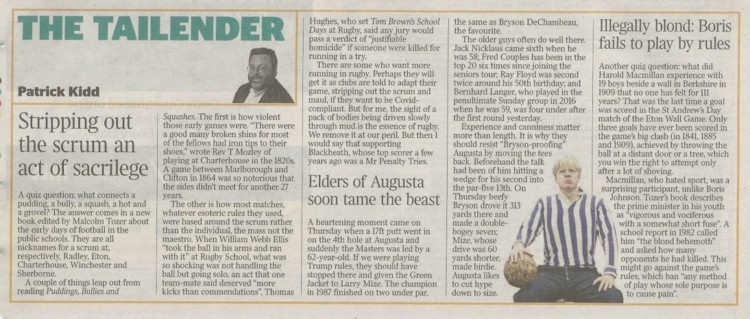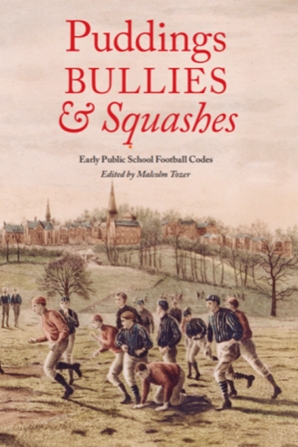In September 2019, in one of my first acts as College Historian, I represented Clongowes at the British Society of Sport History Annual Conference in Liverpool Hope University (see here), where I presented a paper entitled: «‘All the other boots and legs ran after’ – the long life and slow death of ‘Gravel’ football».
As a result of my presentation I was asked to contribute a chapter to a forthcoming volume on Early Public School Football Codes, where we were in august company amongst the likes of Charterhouse, Eton, Harrow, Marlborough, Rugby, Westminster and Winchester.
The book has now been published and a copy has just dropped onto my desk and is a marvel to behold. It has been receiving favourable notices, not least in the Sports section of The Times (of London) and Rugby World has included it in its list of Best Rugby Books 2020 (alongside Old Clongownian, Rob Kearney – see here).

I am sharing an ‘abstract’ of the chapter in here.
‘ALL THE OTHER BOOTS AND LEGS RAN AFTER’
The long life and slow death of ‘Gravel’ football.
It is just one hundred years since the demise of the unique game of gravel football, which thrived in Clongowes Wood College for much of the Nineteenth-Century. Clongowes was founded in 1814 and the Jesuits brought with them the complementary seasonal diversions of cricket and gravel football accompanied by handball, paper chases, skating and hurling. ‘The Stonyhurst Game’, as it was called, embodied many of the elements of rugby, soccer and gaelic football and predated all three but would eventually succumb to the first two as they grew in strength and the needs of the school, which harboured it, changed.
The game was played on a gravel surface (to save the cricket grounds in the winter) with tall pine goal posts (without cross bars) facing one another diagonally across the ground. The balls, made in advance of each game by the college shoemaker, were small, weighed about twenty five ounces, quickly became misshapen and had to be replaced several times in a match. One Old Clongownian described his first view ‘of boys kicking very pebbly looking footballs’ and explained that ‘the flabby football…when…wet…became paved all over with little particles of gravel’. In this condition it was ‘truly horrible, a terror to many and a prolific source of fights’.
Play was advanced mainly through the primary skill of ‘forcing’ – that is dribbling the ball towards the opponents’ goal and one point was awarded for every score. The game was played from the start of September until St. Patrick’s Day, when the season concluded with the Colours Matches. These gala occasions, which foreshadowed the schools’ rugby finals of today, were a high point in the college calendar and were preceded by preliminary rounds to decide which team sported red and which green. Following a ceremonial march to the ground ‘with colours flying’ the rector gave ‘the initial kick-off’ before retiring ‘amid cheers’. Christopher Palles, Lord Chief Baron of the Exchequer, first president of the Clongowes [past pupils] Union, and arguably ‘the most distinguished Old Clongownian of [his] day’ recalled that for every goal scored on St Patrick’s Day ‘there was an extra pancake at dinner for the scorer, with the thoughtful proviso that a boy could transfer his extra pancakes to his friends!’
The only ‘out-match’ was that played against the gentlemen of the past ‘for the very good reason that they were the only people outside Clongowes who knew how to play the game’. The present pupils normally won these games over the past ‘because they tired early’. This is not surprising if the account of one such match is to be believed, in which the teams played for an hour and a half, ‘adjourned for dinner, and then went at it again for another hour and a half!’
Gravel football was extraordinarily popular in both Clongowes and Tullabeg as described in James Joyce’s Portrait of the Artist as well as in the writings of other Old Clongownians. This chapter tells the story of ‘gravel’, which had its own detailed set of laws, (including the peculiar provision that the first score was reckoned as only a half, to make draws impossible) and its place in the Ratio Studiorum that formally established the system of Jesuit education.
Here is the
Here is a Press Release shared by SUNNYREST BOOKS
 PRESS RELEASE
PRESS RELEASE
PUDDINGS, BULLIES & SQUASHES:
Early Public School Football Codes
Edited by Malcolm Tozer – Published October 2020
Football’s pre-eminence in the world has often been ascribed to its simplicity – the rules are easy to grasp, the game in its rawest state easy to play. Britain is not necessarily the birthplace of football, but it is where the two principal codes of football, association and rugby, were given shape, form and discipline.
The cradle for the codification of football was the nineteenth century public school. Rugby School is well known as the originator of its eponymous code, but in the mid-nineteenth century there was a remarkable set of locally varied rules under which “football” was played. Some, such as the Eton Wall Game, have survived but most have withered away, assimilated into the now highly professional sports of football and rugby.
This is the story of twenty of those schools, from Dublin to Dorset, Edinburgh to East London, and their versions of football. Many were shaped by the space available to them, whether grass or stone, large or small, kicking or handling. All of them were robust, vigorous and hazardous. This book is a collection of new essays that traces the evolution of the modern games.
The title alludes to the imagination of those far-off schoolboys: puddings, bullies and squashes were the terms used at Radley College, Uppingham School and Charterhouse respectively to describe that distinctive feature of every early public school football game – the melee. The massed boys of one team pushed hard to drive the ball through the opponents’ goal while the defenders did their utmost to thwart it.
With an introduction by the sporting historian Tony Collins, the book gives a wonderful flavour of the variety of those early public school football codes before the nationalisation of the game by the Football Association from 1863 and the Rugby Football Union from 1871 ended the arguments under whose rules matches between schools should be played.
Clongowes is one of twenty schools represented in the collection. The Clongowes essay on its very own code of Gravel Football (described in Old Clongownian, James Joyce’s, Portrait of an Artist as a Young Man) was written by Declan O’Keeffe, College Historian and explains (amongst other things) why the first score in any match was only worth half a point…
……………………………………………………………………………………………………………….
The book is available to buy on Amazon.
Inicia sesión o Hazte miembro
para crear y ver comentarios

